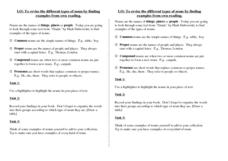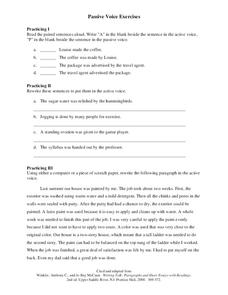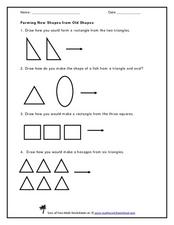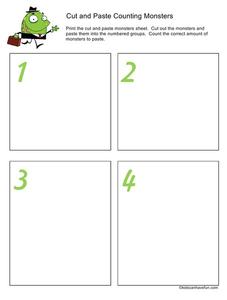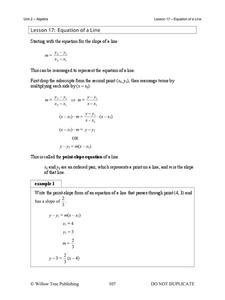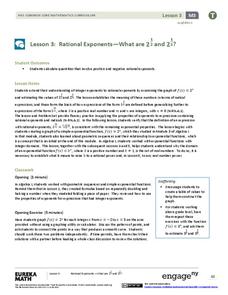Curated OER
Fraction Manipulatives
In these fraction worksheets, 5th graders use the fraction manipulatives to help them learn and visualize fractions. Students then solve 5 fraction problems.
Curated OER
Bear Multiplication
In this multiplication facts worksheet, students use small plastic bear manipulatives to solve 8 basic multiplication problems.
Curated OER
Algebraic Manipulation
In this Algebra I worksheet, 9th graders evaluate algebraic expression by substitution. Problems include exponents and parenthesis. The two page worksheet contains thirty problems with answers.
Curated OER
Molarity
In this molarity instructional activity, students determine the concentration or molarity for each of the solutions. Students manipulate the molarity formula to calculate the moles, mass, or volume of each problem.
Curated OER
WS 1.0 Math Skills Update
In this math skills worksheet, students solve a variety of basic math problems such as solving for "x" in different types of equations, manipulating algebraic expressions, converting from ordinary notation to scientific notation and...
Curated OER
Apple Addition Cards
Kids love games and manipulatives, they make learning math fun. Print this set of 10 cards and the attached markers. Learners use the cards as a game, where they count the apples of the card then place a marker on the correct answer.
Curated OER
Rate Law Problems
If you need a variety of questions for reactions and rate calculations, this resource is for you. Inspire your students to manipulate values and equations to fit the questions. The word problems are quite involved and require young...
Curated OER
Passive Voice Exercises
Strengthen understanding of grammar and syntax with this task. First, grammarians identify the active and passive voices, then they rewrite individual sentences to be in the active voice before manipulating an entire paragraph. Great...
Curated OER
Forming New Shapes from Old Shapes
Shapes can be joined together to make new shapes! Young geometers experience this phenomenon as they examine four shape challenges in this worksheet. Scholars create a rectangle from two right triangles and a fish from an oval and a...
Curated OER
And 1 More Makes...
If we add one more, how many will we have? Beginners to addition practice this skill using images and counting as they draw one more sock to each set and record the new total. There are three of these followed by four more similar...
Curated OER
And 5 More Makes...
By drawing five more objects to existing sets, scholars begin to understand the concept of addition. They count pails and draw five more, totaling them and recording the sums. There are three of these followed by four more similar...
Curated OER
Count How Many
How many now? Math beginners will benefit from this introduction to addition which doesn't even include addition symbols. They read number sentences in word form; however the numbers are in numeric form (for example, "1 and 2 more...
Curated OER
Finding 10s
For beginners to addition, sets of objects are the ideal way to make this concept understandable. For each of these sets they ring 10 and count the remaining. Then, scholars fill in the addends as 10 and the remaining number. The sums...
Curated OER
Good Vibrations
Third and fourth graders should enjoy this easy-to-implement activity involving a straw, and bottles filled with water. Learners manipulate the end of a straw in a way that results in a sound being made when it's blown. There is also an...
Curated OER
Parts of the Face
Manipulate the components of a face, and learn the Spanish words for eye, nose, mouth, ear, hair, teeth, tongue, and eyebrow! After your beginning Spanish pupils design a face, have them pair up and practice naming the parts of the face.
South Gloucestershire Council
Animal Classification: A Collaborative Sorting Activity for Key Stages 2 & 3
Introduce the logic behind a dichotomous key or administer a group performance assessment with a fun and challenging classification lesson. With explicit instructions for the teacher and for collaborative groups, as well as engaging...
Curated OER
M&M Science and Math
A series of math and science activities feature M&M's® as manipulatives to help kids work through equations. The resource includes exercises on finding averages, percent of compositions, moles in chemical reactions, genotypes and...
Kids Can Have Fun
Cut and Paste Counting Monsters
Young children will have a blast learning how to count these monster math manipulatives. Provided with a series of boxes numbered from 1 to 10, learners must place the correct number of monsters in each space to demonstrate their ability...
It's About Time
Conservation of Momentum
Assist your class with understanding collisions as they apply the Law of Conservation of Momentum. Pupils measure the momentum before and after manipulation of two objects so that one strikes another in an inelastic collision. The lesson...
It's About Time
Atoms with More Than One Electron
Provide young chemists with the ability to manipulate atoms and predict their results, in this sixth lesson. Pupils analyze energy patterns as they predict the amount of energy required to remove electrons from atoms. They compare trends...
Willow Tree
Equations of a Line
Each form of a linear equation has its purpose — pupils just have to find it. Building on the previous lesson in the series, learners examine point-slope and standard form. Using point-slope form, pupils write the equation of a...
Mathematics Assessment Project
Funsize Cans
Designing fun-size cans ... what fun! Class members use the provided questions to determine the dimensions of a can with a minimum surface area for a given volume. The task allows learners to use graphs or algebraic manipulation to solve...
EngageNY
Rational Exponents—What are 2^1/2 and 2^1/3?
Are you rooting for your high schoolers to learn about rational exponents? In the third installment of a 35-part module, pupils first learn the meaning of 2^(1/n) by estimating values on the graph of y = 2^x and by using algebraic...
Illustrative Mathematics
Transforming the Graph of a Function
Function notation is like a code waiting to be cracked. Learners take the graph of an unknown equation and manipulate it based on three different transformation changes of the function equation. The final step is to look at three points...
Other popular searches
- Math Manipulatives
- Fraction Manipulatives
- Addition Using Manipulatives
- Fractions With Manipulatives
- Geometry Manipulatives
- Division Manipulatives
- Manipulatives Adding Doubles
- Manipulatives Math Lessons
- Mixed Number Manipulatives
- Manipulatives Lesson Plans
- Manipulatives Place Values
- Edible Manipulatives



